A HISTORY of
the TOWN of AMHERST, NEW YORK
By
SUE MILLER YOUNG
1965
Previous
Chapter | Table
of Contents | Next
Chapter
Chapter 18
The Mills of Amherst
One
of the early saw mills was
located on the north side of Main Street
near Union Road. It was built by John Long in 1808 and used water from Long's
Spring Brook, which originated in springs on the south side of Main Street on the present site of a large
supermarket and ran north through the Long farm. The brook still flows,
paralleling Union Road, passing through the
Forest Stream development and adjoining the Park Country Club where it
meets Ellicott Creek. The mill was erected to saw the timbers for the farm house
located near the spring.
|
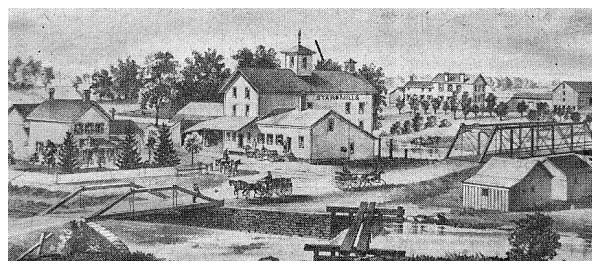
|
|
The Long Mill |
Another
saw mill was located on North
Forest Road at Ellicott Creek and was
owned by Jacob Getz. Because there was only a succession of riffles and no falls
at the location, a millrace was built to carry water under the road to the mill
some distance away on the bank of the creek. As the water left the wheel by way
of the tail race, it returned to the creek above the mill.
Two mills were operated by water from sulphur springs on Fogelsonger Road
(now Park Club Lane, directly northeast of Neumann High School). The larger,
constructed by George Fogelsonger, became known as the Dean Grist Mill. It was
about 35 by 50 feet in size, of plank construction, three stories high and had a
winding stairway and a fourteen foot overshot wheel. A dam formed a good sized
pond from the flow of the springs
and the plank race ran (eventually under the railroad track) to form a brook
that led to another mill in what is now the Morningside Development. The Dean
Mill burned in 1904, but traces of its existence are still noticeable.
The
other mill was located between the lot lines of what are now 560 and 564 North
Forest Road and was owned by John Batt. It was operated by water from the
sulphur springs, after it left the Dean Mill, and by water at the falls of
Long's Spring Brook. This was a combined mill, producing grist on the north side
and cider on the south side of the structure. John Batt sold the mill to Edwin
C. Root (or Rutt) in 1875. Ellen Longnecker, sister of Edwin Root, became the
next owner and sold it to Phillip J. Snyder in 1880. The mill was operated
by his son, Edward, until 1910 where it was destroyed by fire. In 1913, the
property was sold to Dr. W. H. Mansperger.
As
early as 1806, William Maltby erected a saw mill and a grist mill on what is now
Millersport Highway, just south of North Forest Road. In 1815 it became Frick's
Mill and, in 1877, the
Skinnersville or Wolf's Mill-the property of George G. Wolf. At the later date
it was a saw, grist and flour mill doing a flourishing business, delivering
loads of flour to Buffalo every day under the brand name "Star."
During February and March logs were sawed and the mill employed as many as
sixteen men whose meals were furnished. The mill was operated by a flat turbine
type wheel run by water power when there was a sufficient supply. When water was
low, the mill operated by gas engine, supplied from a gas well on the premises.
The
mill has been idle for years and, while it has deteriorated, it is still
recognizable. At the time of writing, Mrs. Estelle Allenbach, a daughter of
George G. Wolf, lives on the property with, her son.
THE
REIST MILL
John
Reist came to Williamsville in 1808
and bought a farm of 196 acres,
extending from Mill Street almost to Reist Street. His brother-in-law, Abraham
Long, bought the property facing Reist Street and, in 1821, a flour mill for the
Reist Milling Company was built on the two properties, with the lot line passing
through the center of the mill.
|
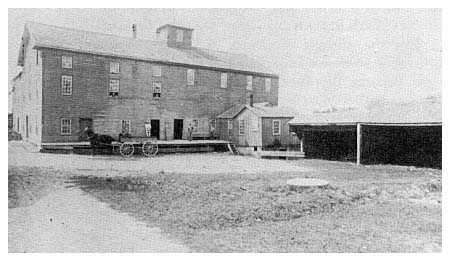
|
|
The Reist Mill |
The main building is still standing on its original stone foundation.
Preserved are the cupola, two dutch doors with long wrought iron strap hinges
and their original latches and locks, much worn floor boards and octagonal
shaped walnut posts that support the loft. One of the
bearings for the 12-foot wooden overshot water wheel is still visible and
the topography of the area reflects the millponds, the mill race to the wheel
that passed under a bridge at the side of the mill and the
raceway that led to Ellicott Creek-near the present fifteenth tee of the
Park Country Club.
The
mill prospered and expanded. On a map of John Reist's farm, drawn by his
grandson Warren D. Reist, are shown the following: Grist and flour mills, hemp
mill, saw mill, mill barn, several mill ponds and embankments, cooper shop, the
large farm house, a two-family mill house and a tenant house for saw mill and
farm hand (where the Jerry Shiesley family lived). There was also a teamster's
dwelling, carriage house and sheds for ox and horse teams. A road ran from Reist
Street at the mill, across the entire farm to Mill Street and there was a
proposed Elm Street, to parallel Bear Street (Glen Avenue) from Reist Street to
Rock Street.
In 1830, John Reist became a preacher of the Reformed Mennonite Church
that is still in existence at Main Street and North Forest Road. He leased the
mill and, with his son Christian as a partner, became involved in several
financial investments.
They
bought stock in the Lake Navigation Company, an interest in the Hollister Grain
Elevator, a steam boat to sail on Lake Erie and a scow for use on the Erie
Canal. They purchased wheat in Detroit, shipped it to Buffalo on their own boat,
hauled it to the mill, ground it into flour and then shipped it to New York in
their own scow via the Erie Canal.
But the church of which they were members decided a minister should not
invest in stocks or in a corporation which might become involved in litigation.
(The New Mennonites, in exact obedience to New Testament admonition, did not
resort to law for redress of grievances.)
John Reist loved his church more than money, so in 1846 he and his son
sold out their stocks and took over management of the local mill. They
immediately hired Reuben Lintz to enlarge
the mill and install a second water wheel with a roller system to supplant the
original two-stone system. Now Grade A flour could be made.
John H. Kline became millwright, engineer, mechanic and superintendent of
all carpenter work. Soon the mill was producing 100 barrels of flour a day
besides grinding rye, buckwheat
and "custom feed." Two grades of flour were manufactured and sold
under the brand names of "Golden Eagle"
and "Arlington."
In 1868-70, the water supply became inadequate. A large dam was built
across Ellicott Creek, just to the north of the bridge on Glen Avenue. While it
belonged to the Reist Mill, the dam became known as the "Forge Dam"
because the Greybiel Forge was
located on its banks.
|
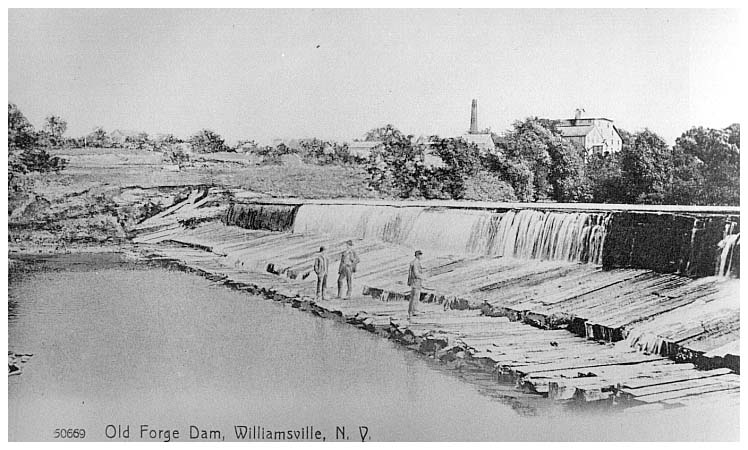
|
|
Old Forge Dam 1854 |
The raceway ran west to join the stream that still flows in front of St. Francis Home on Reist Street, to form a large mill
pond. While the pond is no longer in existence, its contours, at the bend of Reist Street, are still obvious.
One of the most ambitious ventures of its time, construction for the
water supply cost $7,688.15. Included
were $305 worth of water lime purchased from Benjamin Miller, $28 worth
of sand from Gardner Green and $61 worth of sand from Lucius Bestow. The
Uebellhoer quarry supplied six "cords of stone"
for $10.50. More than 90 men were employed during the construction and wages ranged from $1 per day for laborers to
$4 per day for experts.
In 1870, the two over-shot wooden wheels were replaced by Laffel wheels
and, in 1880, a steam boiler and engines were installed. The
property was sold to Joseph Kuhn and Sons In 1893 and the mill was
operated by them until 1903 when the
entire plot was purchased by the Sisters
of St. Francis.
The Dodge Mill
About
1811 Jonas Williams built a crude mill on the high east bank of the Ellicott
Creek, just above the falls north of Main Street. Since the dam above Main
Street and the race to the mill were not built until 1834, the original mill
must have operated on water taken directly above the falls.
On
the Main Street front of the same location he built a tannery and operated it
until 1819 when it was purchased by John Hutchinson. The fact that the tannery
burned in 1872 may have been portentous because the mill changed hands seven
times involving many partners and individual owners, before it also burned in
1894.
|
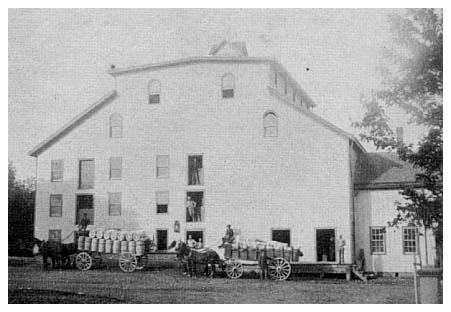
|
|
Dodge Mill |
After
operating the mill for only three years, Jonas Williams and his wife Elizabeth
sold it in 1814 to Storrs Brothers and Benjamin Caryl who lost it to creditors.
The mill reverted to James Roosevelt and others until 1827 when Oriel and Phoebe
Smith acquired it for $8,000 by Sheriff's sale. They in turn sold it to Benjamin
and Esther Hershey for $6,000 in 1831. They built the upper dam that is now at
the tip of Island Park and a race that led, under Main St., to the mill that was
now able to produce flour. (Peculiarly, the race became what is now
the main bed of the Ellicott Creek. The main bed of the creek in 1831 is
now the smaller, shallower waterway that completes the island.)
The next owners, in 1845, were Henry B. Evans, Christian Root and John
Witmer, who paid $9500 for the mill and sold it in 1852 to Benjamin
Miller-Christian Root retaining half interest. Early in 1864, the owners were
Alexander Gotwalt and his wife, Harriet A., and Henry Gotwalt and his Wife,
Harriet M. During the same year, they sold to William G. Lee and Jonathan Dodge
for $10,000 and Mr. Dodge eventually became sole owner.
He repaired, refitted and enlarged the mill so that it had twelve sets of rolls, producing about 3,000 barrels of flour
per year under the brand name "Favorite." In 1881, the mill was
purchased by his sons Leonard and Henry, and became one of the most important
industries of its time.
|
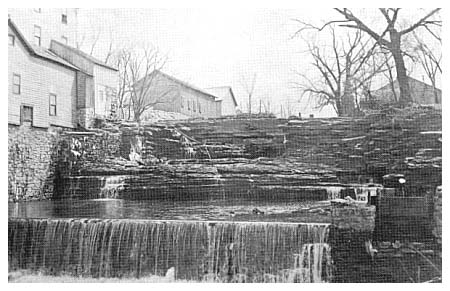
|
|
Dodge Mill before it Burned |
On June 15, 1894, about four o'clock in the morning, Mr. Leo
Daniel, the night miller, discovered fire in the basement. He ran to Mr. Dodge's
home to give the alarm and then to the home of the foreman, John Klute. When he returned to the fire
with Mr. Klute, the mill was beyond saving and Mr. Dodge was missing.
When the fire was finally extinguished, large
gangs of men worked to remove thousands of bushels of grain in search of Mr.
Dodge's body which was not uncovered until the next afternoon. Search of the
ruins showed that a hose which connected with a 200 barrel tank in the top of
the mill had been partly strung out to where Mr. Dodge's remains were found,
indicating that he had lost his life trying to save the property.
|
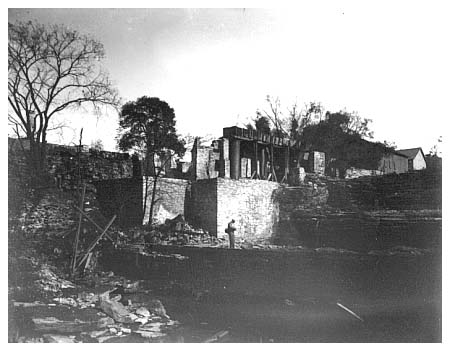
|
|
Dodge Mill 1894 |
The total loss was estimated at $50,000, the property was insured for
$30,000, the mill was never rebuilt and, for years, the smoke stack stood as a
marker for the grim tragedy. The stone foundation of the engine house can still
be seen near the wall of the creek at the rear of the home at 42 Mill Street.
THE
WILLIAMSVILLE WATER MILLS
Tradition,
heritage, civic pride and enterprise are reflected in the Williamsville Water
Mills. Erected in 1811 by Jonas Williams, after whom Williamsville is named, its
ownership passed through the hands of many forefathers of present generation
Amherstonians before being restored and reconditioned in 1947 by the late Daniel
Niederlander. This summary is compiled from information, deeds and records
furnished by him and his wife, Grace Niederlander, granddaughter of Benjamin
Miller who was owner of the mills in 1866.
|
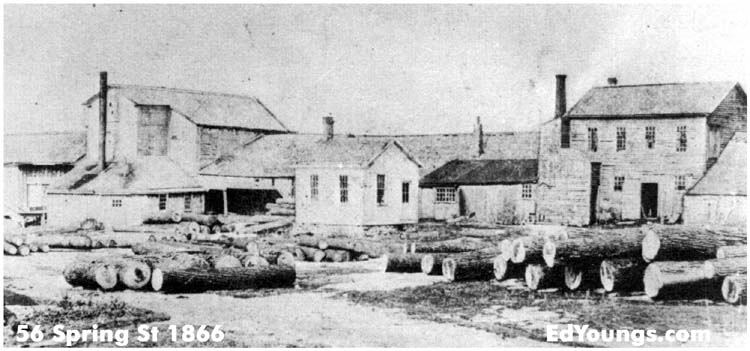
|
|
Williamsville Water Mill 1866 |
Jonas Williams abandoned his first mill on the east side of the Ellicott
Creek during the first year (I811) to build the present mill on the west side of
the creek. A stone dam was constructed at what is now the north end of Island
Park and a stone lined raceway carried the water from the mill pond to the mill.
The dam and raceway are still in use, although the race is now covered as it
flows under Main Street and adjacent buildings.
In
1814, Williams sold the mill with certain land and all the mill rights to Juba
Storrs and Company who also had interests in Canada and Canandaigua, New York.
Because Williams owned land adjacent to the mill pond, he required the company
to lower the dam, probably to prevent his property from becoming flooded. The
following year, Juba Storrs and Company leased property on the east side of the
creek to erect a carding mill on the site of one of the present parking lots of
the amusement park. They also established a store at Main and Rock Streets where
the Marine bank now stands.
|
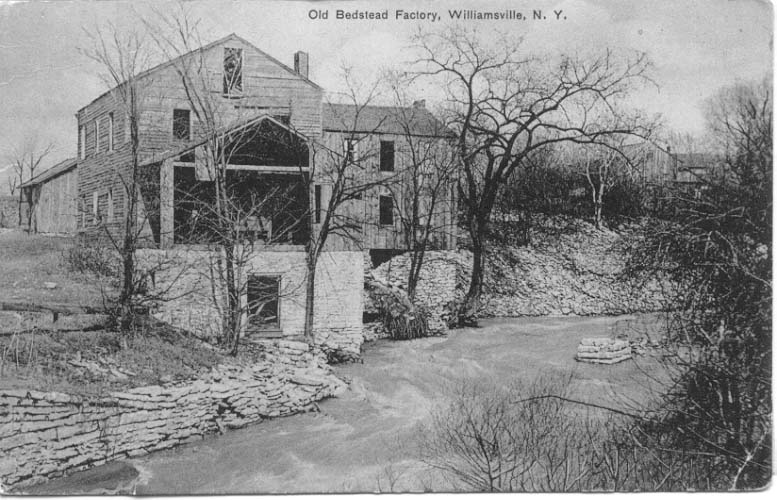
|
|
Carding Mill - Bedstead Factory |
During
the War of 1812, however, Juba Storrs and Company had invested heavily to stock
their stores. They had purchased $40,000 worth of merchandise with $14,000 and
credit. After the war they could not dispose of the stock and were forced into
bankruptcy in 1820.
Seven years later Oziel Smith came into possession of the mill by
Sheriff's Certificate of Sale and, in 1831, sold the property to Benjamin
Hershey. In 1834 Hershey also purchased the "Upper Dam" which still
exists.
Some historians claim that the manufacture of hydraulic lime began at the
mill in 1822 to supply cement for the locks of Erie Canal at Lockport. But
Smith's deed to Hershey states that he "is selling a grist mill." It
is probable that the manufacture of cement began about 1825.
After various transfers and foreclosures, the property passed to John S.
King, Timothy Hopkins and Jairus Tefft in 1844. Tefft sold his interest to Mr.
Hopkins in 1857 and the firm became Hopkins and King who operated the cement
mill, a saw mill and lime kilns and who also owned and operated the Eagle House
Tavern. A county tax bill of 1857 shows that the assessed valuation of the
properties was $10,500 and that the county tax was $44.01.
Later, King sold his interest in the mill to Hopkins, who became sole
owner. At the same time Hopkins sold his two- thirds interest in King's
residence on Main Street. King sold the house to Nancy E. Zent in 1863. Later
owners were Miss Ida Zent, Miss Grace Ely and, eventually it became the home of
the Niagara Permanent Savings and Loan Association.
Through the courtesy of Miss Grace Ely and other directors of the
association, the original home was acquired by the Niederlanders who moved it to
the mill site where it is now called the "miller's house," occupied by
the present operator of the mill.
To return to the story of the mill ... In 1866, Timothy Hopkins sold the
property to Benjamin Miller, who formed the Williamsville Cement Works with his
son, Edward B., and established offices and warehouses on Scott Street in
Buffalo. When Benjamin Miller died in 1822, the mill continued to be operated by
his son.
In
1887, Edward converted the cement mill to a feed and flour mill and renamed it
"Eclipse Mills," featuring pure buckwheat flour.
In early 1903, heavy ice formation on the flume along the side of the
mill caused the flume and saw mill to collapse into the creek. The saw mill was
never rebuilt. A beautiful garden now marks its site. But with many men at work,
the flume was rebuilt in time for the busy fall season.
|
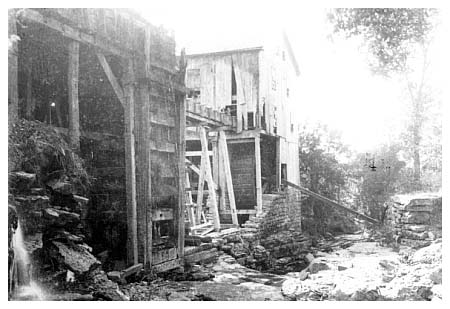
|
|
The Eclipse Mill 1900 |
When Edward Miller died in 1905,
the executors of the Benjamin Miller estate sold the mill property to Joseph G.
Jacobi who, in turn sold one-half interest to Ferdinand Senf. In 1908 the mill
was modernized. A 100 H.P. water turbine re- placed the large wooden water wheel
as the driving mechanism for newly installed "two run of 54-inch French
bury stones." A cider press was installed.
Between 1917 and 1919, Jacobi and Klein were listed as the owners, when
litigation with the Village of Williamsville was necessary to establish their
rights to the water in Ellicott Creek.
In
1947 Jacobi and Klein sold the property and all water rights to Daniel B. and
Grace Miller Niederlander. The bright red mill, reconditioned and still
operating, can be seen from Main Street. Visitors are welcome-not only to
purchase the stone ground grains and cereals (that are still distributed in
packages featuring the original wood block label), cider in season and
reproductions of colonial items-but to view the vast selection of original early
Americana on display, collected over many years by Mr. Niederlander.
|
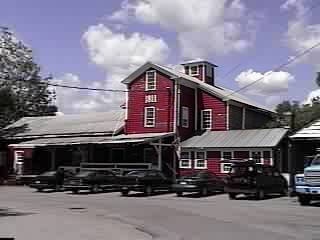
|
|
Williamsville water Mill 1998 |
OTHER
MILLS
On
a map of 1866, a mill is shown at Mill Port (Millersport), west of Transit Road
and south of Tonawanda Creek. No record of its purpose or production was kept
until the property was purchased by John Hockhadel in 1875. The dam was located
behind the present property of John Wiedenbock, whose wife is the daughter of
John Hockhadel. When water became scarcer the mill was abandoned and used as a
blacksmith shop.
J.
Pfening also had grist and cider mills there, but both were abandoned.
A
flax mill was located on the stream that crosses Main Street at Amherst Central
High School in Snyder and there were other mills in Amherst which have left no
records. Certainly the-re were many saw mills, constructed where there was a
fall of water, generally for the purpose of sawing lumber to build a house at,
or near, the site. Some of the settlers had brought with them what was known as
"mill irons" that, today, are prized possessions.
But, while industry was instrumental in the development of the Town of
Amherst, it has given way primarily to residential expansion with attendant
services and limited, but desirable, 'light industry, research and educational
areas.
Previous
Chapter | Table
of Contents | Next
Chapter
Click Here to see more pictures
 |
 |



